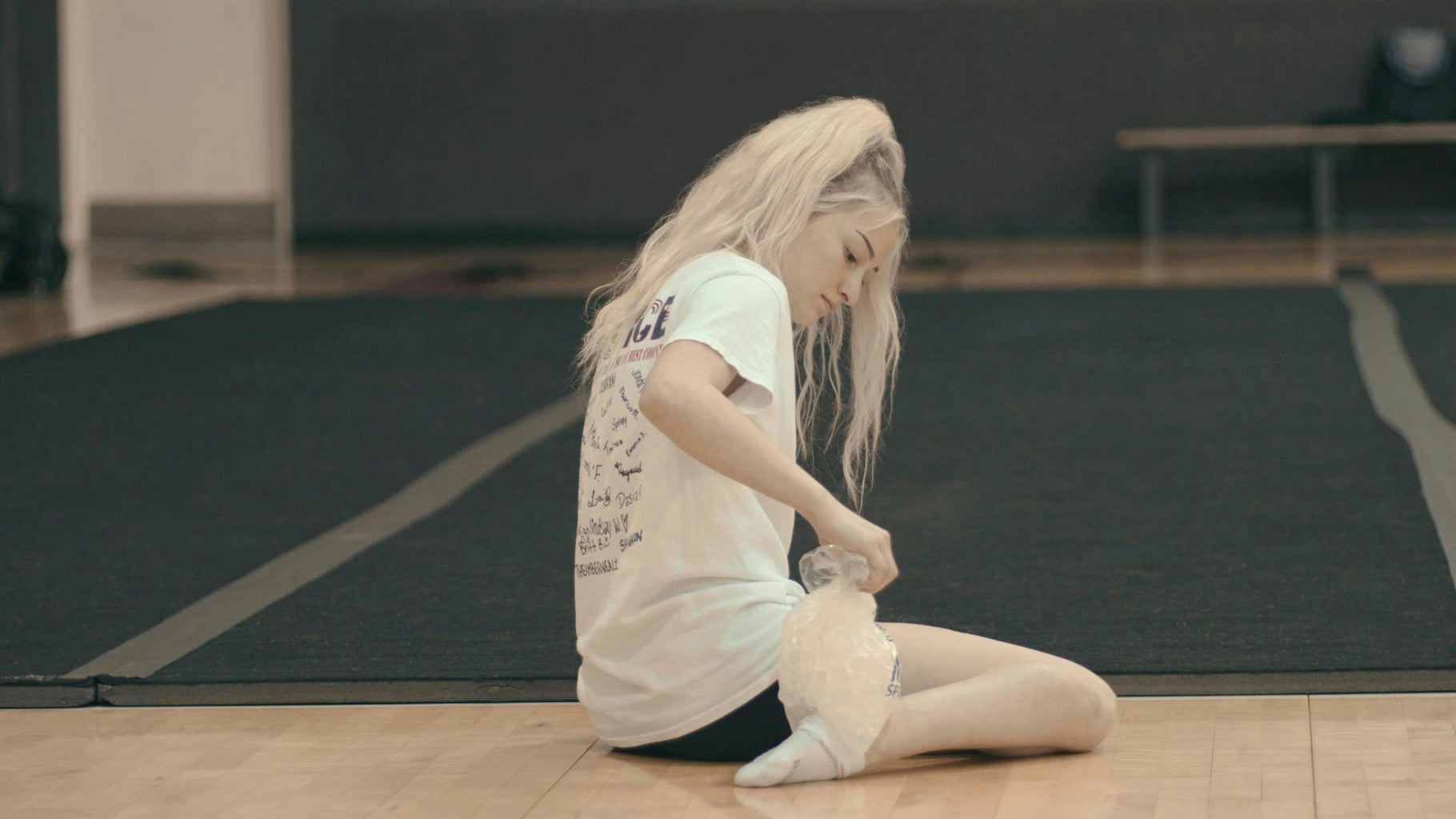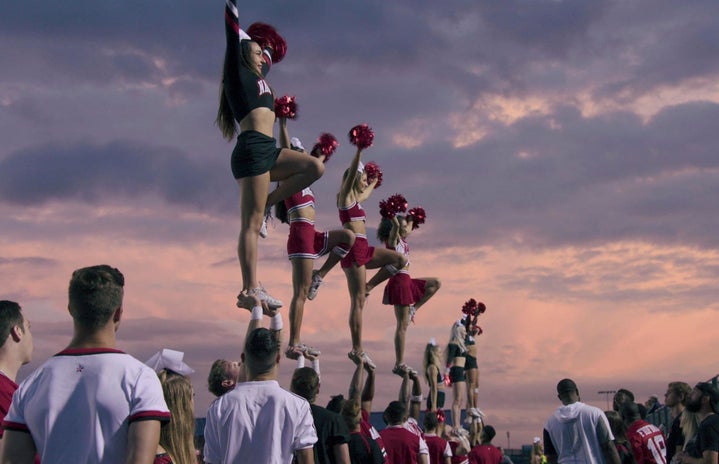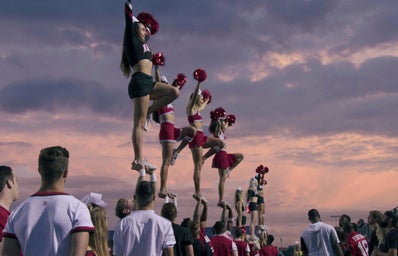Raise your hand if Bring it On was your sole determinant for what it was like to be a cheerleader when you were growing up. Savage teammates gunning for your spot, vapid young women viewing themselves as the be-all, end-all of popularity, and a head cheerleader as the only coach to the whole squad. Stolen cheers and copycat choreo fueled the team and, as someone who can barely even name a single football team, I easily went along with it. Yeah, sure–cheerleaders are slimy routine thieves, stomping on the backs of whomever they must to climb to the top of the metaphorical pyramid. That tracks.
Until it didn’t. Enter Netflix’s most recent bingefest Cheer, which fully flipped the script on cheerleading as the cameras followed Navarro College’s 14th NCA Championship season. Showcasing near-impossible athletic feats—hello, girls being launched to land feet-first on the shoulders of somebody who is already standing on the shoulders of somebody—as the cheerleaders pushed through the pain of horrifying injuries. The docu-series cultivated the utmost empathy for members of the team through vulnerable, honest exposés of their pre-Navarro lives and fierce fights to make mat for the competition. “[Cheer] show[s] the grit, and the determination and the athleticism that these kids have, and I think that that’s kind of the hidden thing that people don’t realize,” head coach Monica Aldama tells Her Campus. “And that’s what I’m most proud of–that it really gave the outside world an inside look at what these kids do.” Finally, the world got to see what cheerleaders really put themselves through to be the best. Instead of sneaking around, snooping on other teams, they’re practicing several times a day. Instead of rooting for another’s downfall, they jump to action when one of their teammates is in need. Instead of refusing to get their hands dirty, they’re elbows deep in community outreach, including a mentoring program with elementary students and participating in High-Five Fridays, where different teams greet incoming students in the morning to pump them up for the day.

What Bring It On was missing was their own Coach Monica; her cheerleaders wouldn’t be able to do what they do without someone like her. Since jumping into the position on a whim, she’s coached the team to 14 national championships, 5 grand national championships and the record for the highest score in the history of the NCA College Nationals, and while those first accomplishments signified the beginning of the building of something special, nobody anticipated just how special it would become as the Navarro team bloomed into a family. “[What] I wasn’t anticipating was that these kids needed much more than a coach. …They had real life problems, and as they started coming to me I realized I needed to get better at being able to mentor them and being an advocate for them.” Monica wanted her team to feel safe in asking for guidance, dynamics that aren’t often seen in sporting pop culture. “The kids have to feel like that’s a safe place for them. They have to feel like you’re there to help them, like you’re going to have their back. None of us are perfect, so they shouldn’t be scared to let you know if they’ve done something that they think might be disappointing. They still need that guidance on how to overcome any kind of situation,” she says. “That’s going to change the entire environment.”
The environment that Monica created was a home for many of the members of her team. Various members of the Cheer team described Navarro as their place in the world, and have affirmed their place on the team as having changed their lives in ways they never could have hoped for. Lexi Brumback had been doing all-star cheerleading for a while but had never felt connected to her teammates before. “When I came here, everyone was so nice and outgoing, and really made me feel comfortable to come and talk to them about really anything. [They said] that they would be there for me, and they really did it–it’s the difference between saying you’ll be there for someone and actually being there for someone, and they were actually there for me when I needed a friend.” Morgan Simianer realized the team was more than just that when her teammates showed her that they really did care about her. “When people actually cared about your life, and your health, and if you were doing well in class…it just [really brought out the] family aspect of it,” she says.
Perhaps one of the most poignant themes of Cheer (again, a word I never would have previously associated with any sport, really), is the idea that there’s always a way up, as long as you reach out for the first rung of the ladder. The cheerleaders that opened up about their difficult pasts stood tall as they discussed what they’ve been through, admitting that joining the team at Navarro had saved them. Many people feel shame over rough pasts, even when they had no control over their situations, but Lexi & Morgan both know that the only way to go is up. “Your past doesn’t define you,” Morgan says. “Because you can take any situation and you can obviously go down a bad path, or you can look at it as an opportunity to become a better version of yourself.”
Lexi agrees. “It’s how you move on from it that shows your true colors…[and] there always is hope as long as you’re trying your hardest, putting your heart into whatever you’re doing and put[ting] good into the world; because then, you’ll get good back.” Lexi was a shining example of this when she allowed the camera crew to capture the process of her laying charges against somebody that posted her private photos online, something that we don’t often get an honest look at in the media. It was difficult for Lexi to come out and talk about because it was an embarrassing situation to find herself in, and when you find yourself in a situation that feels embarrassing you don’t typically want other people to know about it. “You feel a lot better after you gain the courage to talk about it and actually do something about it,” she says. “I wanted to come out and actually press charges so that that wouldn’t happen again.” She hoped that others would be inspired to go out and do something about it if they found themselves in a similar situation instead of trying to hide it, which would lead to somebody getting away with a really despicable thing that could lead to it happening to somebody else somewhere down the road. “And I was very grateful for Monica being as helpful as she was. She was the one that set up that whole meeting with the police officers. At first I thought she was going to be upset, but she was really understanding about everything that happened, and she really cared about me, my well-being and my reputation.”
Monica made sure that Lexi knew nothing about the situation was her fault, and wanted to help her take back the power. “I felt like this person had control over her at that moment…and I really wanted her to take the power…and control back in that situation. Which is why I thought it was important for her to talk to the police and take ownership. Yes, this happened, but this is what I want people to learn [from this situation]: the person that posted those photos, that’s the person that looks bad.”

As intimate an inside look as Cheer is, things are not always necessarily as they seem, even when you’re getting all of the above out of it. Cheer is riddled with injuries and, for those with little connection to the sport, it can leave you wondering where the payoff comes from for continuing to operate with bruised ribs–which doctors warned you could break, puncturing your organs if you continued–or for your dislocated elbow when your spotters failed to catch you. Some of these injuries knocked the wind out of me–for just a moment I thought I was watching one student break his neck–but what felt like unmitigated risks to me actually have several steps in place to prevent them from happening. “[Cheer] does show a lot of injuries happening, but it doesn’t really show how much we take precautions so that that doesn’t happen,” Lexi says. “There’s a lot of things we do to ensure safety and make sure that we avoid someone getting hurt, and that’s one thing we really pride ourselves on.” Monica, of course, agrees. “It was six hours you saw, but we were filming for months.”
If for some reason you haven’t watched Cheer yet, here’s your sign. All six episodes are streaming now on Netflix – that’s six hours of all the mind-boggling stunts you loved about Bring It On, hold the pettiness.


